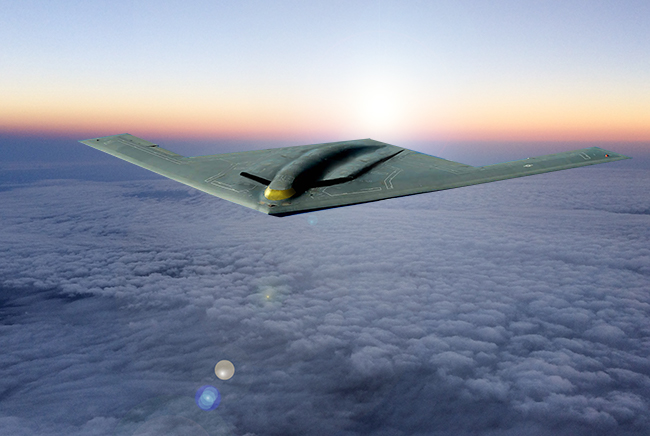
The B-21 Raider is expected to make its first flight in December 2021. Staff illustration by Mike Tsukamoto.
The new B-21 Raider stealth bomber is making good progress and should fly in December 2021, USAF Vice Chief of Staff Gen. Stephen “Seve” Wilson said July 24.
Wilson, speaking at an AFA Mitchell Institute event in Washington, D.C., said the service continues to analyze its capacity for long-range strike. The Air Force still believes it is short, and is reviewing alternative force mixes.
Speaking on deterrence and the need to modernize the nuclear command, control, and communications network, Wilson said he was at Northrop Grumman’s facilities in Melbourne, Fla. in the last few weeks, “looking at the B-21,” and said the company is “moving out on that pretty fast.” Wilson said he has an application on his phone “counting down the days and don’t hold me to it, but it’s something like 863 days to first flight.”
That would put the first flight of the B-21 in December 2021. The Air Force has said from the beginning that the first B-21 would be a “useable asset” but has also said it doesn’t expect an initial operating capability with the B-21 before the “mid 2020s.”
Northrop Grumman CEO “Kathy Warden and her team are focused on software integration and making sure we’ll have the software ready for the plane when it’s delivered,” Wilson said.
The Air Force is “focused on the development of the new bomber as well as modernizing the B-52,” with new engines and radar, “and we’re exploring the force structure between the B-1 the B-2 and the B-52,” Wilson noted. “The general consensus is, we don’t have enough long range strike capacity, and that came out in ‘The Air Force We Need,’ ” study the service published last September.
“We continue to look at what that force will be for the future across the bomber force, what mix it will be.” He maintained the service needs “at least 100” B-21s.”
Air Force Magazine asked Wilson why the service has not advanced the planned number of B-21s, given the acknowledged shortfall in bomber capacity. The Air Force said in “The Force We Need” that it requires another seven bomber squadrons. Increasing the planned buy would also have the effect of reducing the unit cost, by amortizing development over a larger number of units.
“That’s exactly what we’re looking at,” Wilson replied, as well as “what the right balance” will be as B-21s come online. The service has yet to decide if it will extend the B-1 and B-2 bombers—slated to retire in the early 2030s—to increase the bomber fleet or simply go for an all B-21 and B-52 fleet. “But we can’t have four bombers” Wilson said.
Asked if the Air Force will have the new bomber plan by September, or in time for the fiscal 2021 budget, Wilson said only “it may take some time” before the Air Force reaches a final decision. He acknowledged that Air Force Global Strike Command boss Gen. Timothy Ray has openly questioned whether the B-1 and B-2 should be retired as the Air Force has planned.
Wilson also said that while the Air Force “isn’t going to get any new B-52s,” AFGSC might still take “one or two more out of the boneyard.” He noted that Ray has “already brought one B-52 out of the boneyard.”